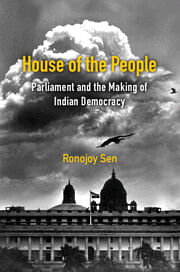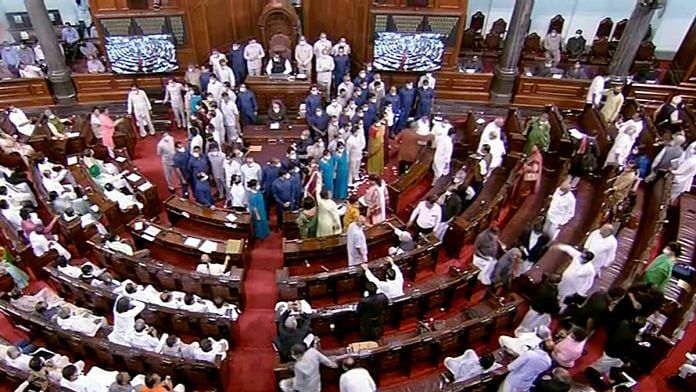Why the rise in disruptions? Going beyond the critical impact of the Indira Gandhi years and the limited efficacy of the rules and disciplinary powers of successive Speakers, the progressive rise in disruptions and protests inside parliament is due to a combination of factors: the more heterogeneous composition of parliament compared to its first three decades of existence; the replacement of a dominant party system with a fragmented one where coalition governments were the norm; the televising of parliamentary proceedings; and finally an acceptance that disruptions were part of parliamentary and India’s political culture. In the first decade of the Lok Sabha’s existence there was a fair degree of homogeneity in the composition of the House with many of the more prominent MPs having been schooled in the traditions of British parliamentary practice. As Shashi Tharoor points out:
Many of our veteran parliamentarians – several of whom had been educated in England and watched British parliamentary traditions with admiration – revelled in their adherence to British parliamentary convention…. An Anglophile Marxist MP, Professor Hiren Mukherjee, used to assert proudly that British Prime Minister Anthony Eden had felt more at home during Question Hour in the Indian Parliament.
It was in this spirit that Mavalankar, on his election as the first Speaker of the Lok Sabha, said on 15 May 1952, ‘An atmosphere of sportsmanship, mutual goodwill and respect is an essential condition for the debates being useful, helpful and effective. This in turn, will mean a disciplined mind, which will respect, not only rules and regulations, but also the innumerable conventions of parliamentary debates.’ More importantly, the composition of the House (discussed in detail in Chapter 2) has become much more heterogeneous – in terms of both caste and class – completely transforming the tenor and idiom of debates. As Ashutosh Varshney has argued about the transformation in the 1990s, ‘Democracy has been substantially indigenized, and the shadow of Oxbridge has left India’s political centre-stage.’
Similarly, Yogendra Yadav has suggested that the period from 1989 to 1999, which he calls the ‘third electoral system’, represented a ‘downward spread of democracy’ which disturbed the ‘inherited ritual social hierarchy’ and the ‘established elite’. This has had an impact on the composition of the Indian parliament and parliamentary discourse. Alongside the displacement of traditional elites, from the 1990s there was a significant presence of regional parties, which, as noted earlier, were keen to make their voices heard on issues that were important to them. The significant change in the way the Indian parliament and MPs conduct themselves could be analysed by using the concept of ‘political culture’.
Also read: 139 & counting — 170% increase in suspension of MPs under Modi govt compared to UPA
In the context of India, Myron Weiner has put forward the idea of two ‘political cultures’: the mass, which is fragmented along caste, religious and linguistic lines and operates in local and state politics but expands outwards; and the elite, which is more homogeneous and can be found among the national leadership, senior administrative cadre and the English-speaking intelligentsia. This is akin to Morris-Jones’s notion of the ‘idioms’ of Indian politics – the ‘modern’, which was about constitutional politics and administration, and the ‘traditional’, which revolved around caste and community (he also identified a third idiom which he called ‘saintly’).
In the Indian parliament, as in parliaments elsewhere in the developing world, the two political cultures or idioms have collided. In the 1950s and 1960s, an elite or a Brahmanical political culture, which set much store by British parliamentary norms and rituals, held sway. But from the 1970s onward and particularly from the late 1980s, there was a democratic upsurge and the language and idiom of mass political culture permeated parliament. As Weiner noted, the two political cultures had an overlap of both modernity and tradition: ‘The struggle between the elite and the mass political cultures is not simply between a modern and a traditional political culture, for there are aspects of both modernity and traditionalism penetrating both views.’
This struggle and the intrusion of the idiom of mass politics inside the walls of parliament undermined the earlier norms of parliamentary discourse and behaviour and brought in with increasing regularity the politics of protest and demonstrations into the House. Political psychologist Ashis Nandy has put it somewhat differently, pointing out that the ‘canonical Brahminic norms’ have over time come to play a ‘more modest and ambivalent role’ in Indian politics.
One might take the liberty of comparing the transformation in the culture of parliament to changes that were happening around the same time in the game of cricket, one of India’s most popular pastimes and passions. Between the 1990s and 2000s, there was a significant decentring of cricket with what was once a metropolitan and elite-dominated sport spreading to India’s interior. This was reflected in the composition of the Indian national cricket team, which until the 1970s was mostly upper caste and Brahmin dominated but from the 1990s had a much more diverse representation. This diversity also found reflection in the playing style and on-field behaviour of Indian cricketers. They were now far more aggressive than their predecessors who were often lauded for their sportsmanlike behaviour and adherence to the spirit of the game. A similar spirit can be seen in parliament from this period. Yogendra Yadav makes this observation about Indian democracy in the 1990s: ‘As more and more participants came to see the game as their own, they brought their own expectations, demands, and beliefs. At least some of the sections hitherto excluded from centres of power thought it was time they had a say in framing the rules of the game.’
The Congress’s formidable majority until the 1980s, except for the brief tenure of the Janata government, meant that the opposition never really had the numbers to seriously challenge the government. Hence, an opposition legislator in the 1950s once ended a debate with the words, ‘We have the arguments. You have the votes.’ This changed from the 1970s with the Congress losing majority for the first time in the Lok Sabha in 1977. By the late 1980s, Congress dominance was history, and there were many more claimants to political power.
Also read: Disruption, suspension, unrelenting opposition—the farce that is Parliament’s monsoon session
This meant a more vocal opposition irrespective of who was in government, with the Congress too indulging in disruptive tactics while in the opposition benches. It is important to note that a single-party majority has generally been a deterrent to disruptions. This was hinted at by Vajpayee in his address to the 2001 Conference on ‘Discipline and Decorum in Parliament and State Legislatures’, where he speculated on the absence of disruptions in the first two decades of parliament: ‘Was it because there was one party rule or was it because we had faith in democracy and firmly believed in the fundamental principle that in parliamentary democracy the majority party will rule and the Opposition will have the full opportunity to put forth their views?
As observed earlier, parliament did suffer severe disruptions during the latter stages of the eighth Lok Sabha when the Congress had an overwhelming majority. It could be argued, however, that this was due to an exceptional issue like Bofors, which galvanized and united the numerically weak opposition. In the sixteenth Lok Sabha, where the BJP enjoyed a slim single party majority, there have been some disruption-free sessions. In the 2014 winter session, for instance, the Lok Sabha functioned for nearly 100 per cent of its scheduled time. Question Hour, the first casualty of disruptions, was the most productive since 2004.
While disruptions were at a low during the first year of the Narendra Modi government in 2014–15, the threat of disruptions was not entirely absent. Disruptions have usually occurred when a government policy or a national issue has united the opposition. The opposition ensured that both Houses of Parliament were heavily disrupted during the short monsoon session of 2015 in protest against what it perceived as wrongdoing on the part of the BJP’s minister of external affairs and state chief ministers. Again the month-long winter session of 2016 was the least productive of the sixteenth Lok Sabha after the opposition united against the government’s sudden and radical decision to demonetize high denomination currency notes, which was announced days before the session began. As much as 92 hours or 73 per cent of the session was lost due to disruptions. Overall, despite a single party majority, the sixteenth Lok Sabha worked for 20 per cent more than the disruption-hit fifteenth Lok Sabha but 40 per cent lower than the average of all full-term Lok Sabhas.
The existing rules and procedures have also meant that the growing number of opposition parties has had little say in setting the agenda of parliament, which is decided by the government, as well as voicing its demands.
Another innovation that possibly helped fuel disruptive behaviour and theatrics has been the live telecast of proceedings inside the House.
Also read: Disruption in Parliament isn’t new. But there was a new aggression in this monsoon session
Finally, the acceptability of disruptions might have something to do with the popularity of Gandhian methods of protest, including satyagraha, in independent India. I had mentioned earlier how the giant Gandhi statue on the premises of parliament is a favourite site for protests. While it might be a good photo opportunity for protesting legislators, the statue of a brooding Gandhi also lends a certain moral authority to such protests. Similarly, disruptions inside parliament arguably derive some of their legitimacy from Gandhian techniques of breaking the law.
The hand-wringing over the decline of parliament misses out the point that disruptions are now as much a part of the Indian parliament as the elaborate rules and rituals borrowed and adapted from the British.
Not only have disruptions become normal in parliament, but MPs also have increasingly come to see them as standard and entrenched parliamentary practice. That is perhaps why many of the solutions mooted to prevent disruptions – suspension of legislators, withholding of daily allowance, making it mandatory for the House to sit for a fixed number of days – are unlikely to be effective.
 This excerpt from ‘House of the People: Parliament and the Making of Indian Democracy’ by Ronojoy Sen has been published with permission from Cambridge University Press.
This excerpt from ‘House of the People: Parliament and the Making of Indian Democracy’ by Ronojoy Sen has been published with permission from Cambridge University Press.



